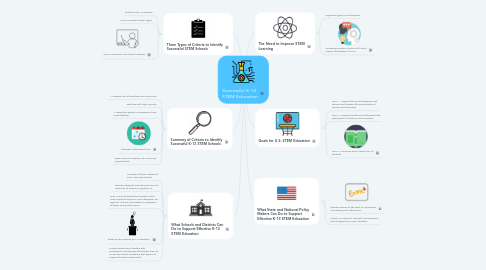Successful K-12 STEM Education
by Vachele Franklin

1. Three Types of Criteria to Identify Successful STEM Schools
1.1. Student STEM Outcomes
1.2. STEM-Focused School Types
1.3. STEM Instruction and School Practices
2. Summary of Criteria to Identify Successful K-12 STEM Schools
2.1. A coherent set of standards and curriculum
2.2. Teachers with high capacity
2.3. A supportive system of assessment and accountability
2.4. Adequate instructional time
2.5. Equal access to quality STEM learning opportunities.
3. What Schools and Districts Can Do to Support Effective K-12 STEM Education
3.1. Consider all three models of STEM-focused schools.
3.2. Devote adequate instructional time and resources to science in grades K-5.
3.3. STEM curricula should be focused on the most important topics in each discipline, are rigorous, and are articulated as a sequence of topics and performances.
3.4. Enhance the capacity of K-12 teachers.
3.5. Provide instructional leaders with professional development that helps them to create the school conditions that appear to support student achievement
4. The Need to Improve STEM Learning
4.1. Significant gaps in achievement
4.2. Increasing number of jobs at all levels require knowledge of STEM
5. Goals for U.S. STEM Education
5.1. GOAL 1: Expand the pursuit degrees and careers and broaden the participation of women and minorities
5.2. GOAL 2: Expand workforce and broaden the participation of women and minorities
5.3. GOAL 3: Increase STEM literacy for all students
6. What State and National Policy Makers Can Do to Support Effective K-12 STEM Education
6.1. Elevate science to the level of importance as reading and mathematics
6.2. Invest in a coherent, focused, and sustained set of supports for STEM teachers


